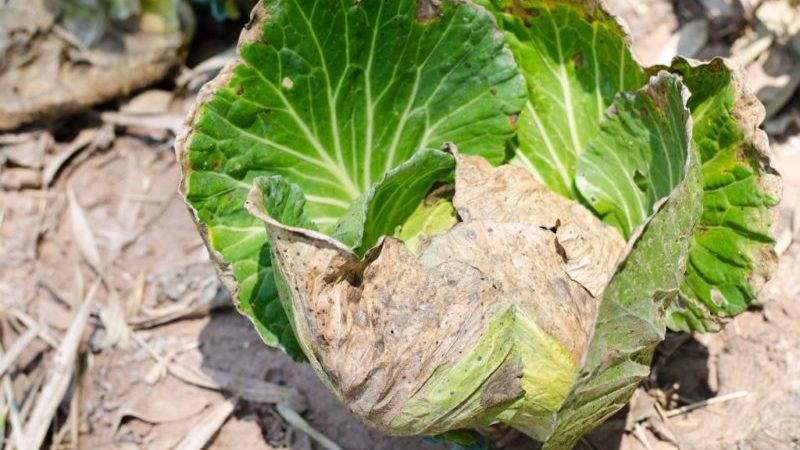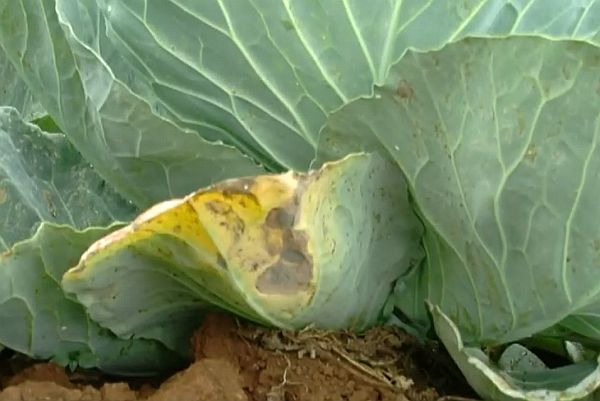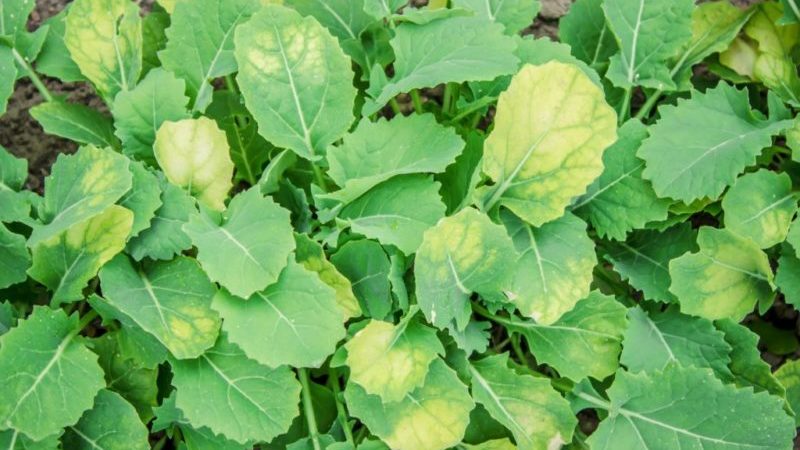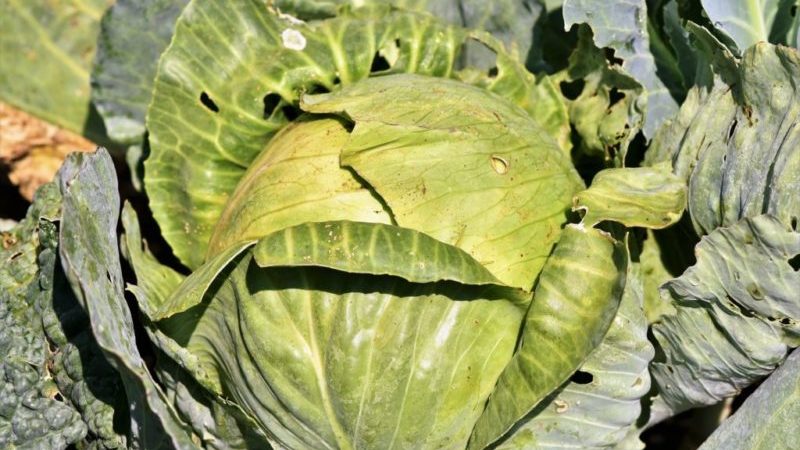Why cabbage leaves turn yellow and what to do about it
The yellowing and wilting of cabbage leaves reduces the yield and taste of the heads, and sometimes leads to a complete loss of the planted crop. To avoid this will help to find out and eliminate the cause of such changes in a timely manner, as well as adherence to agrotechnical and preventive practices in the garden plot.
The content of the article
Why there are problems with cabbage leaves and what to do
In order to save the harvest, it is important at the initial stage to identify the cause of the yellowing of the leaves and take measures to combat this phenomenon.
Leaves turn yellow
Yellowness on cabbage leaves occurs as a result of the following factors.
Culture lacks water
Cabbage is a moisture-loving plant and needs regular watering without stagnant water at the roots. Water the plant in several ways: drip, sprinkler, watering can at the root.
If you are away from the site for a long time, arrange drip irrigation, which will maintain a sufficient level of soil moisture. For the ovary of the head and the juiciness of the leaves in the summer, cabbage is watered every three days, using 2-3 liters of water. In this case, the sprinkling method is used, watering the plants from a hose along the leaf.

Lack of potassium
This element is essential for young cabbage. In addition to the yellowness of the leaves, with a deficiency of potassium, their lethargy is noted.
The problem is solved in two ways:
- Potassium sulfate (10-15 g per square meter) is scattered between the rows and the soil is watered with a hose.
- 10-15 g of potassium sulfate are dissolved in 10 liters of water and the beds are watered with the resulting solution.
Consequences of pesticide treatment

This happens when the dosage is exceeded or the recommendations for the time of day or air temperature during processing are not followed. To eliminate the effects of burns, the frequency and abundance of watering is increased, the heavily damaged upper leaves are removed, treated with growth stimulants ("Zircon", "Epin"), and then pesticides are abandoned.
Burrowing insect pests
Noticing yellowing of the leaves on cabbage, gardeners dig up one plant and examine its roots and the hole in which it grew. If traces of insects are found, the area is treated with special agents.
Harvest is threatened by such pests as: bear, May beetle larvae, wireworm, nematodes. They feed on the roots of plants, which is why it begins to lack nutrients and reacts with yellowness and dryness of the leaves.
Leaf-eating insect pests
The most common are cruciferous flea beetles, aphids, stem weevils, cabbage flies, cabbage leaves. In this case, in addition to the yellow color of the leaves, punctures, bites and gnawed passages are visible on their surface. The plant is stressed and tries to get rid of the damaged parts.
It is better to fight pests before they appear. To do this, the soil for planting is thoroughly cleaned of plant debris from last year's crops and spilled with boiling water to destroy the overwintered larvae and eggs. During the season, weeds are regularly removed, and cabbage is sprayed with a solution based on onions, garlic, wormwood or oregano with the addition of laundry soap for viscosity.
Fusarium

The first sign is the appearance of yellow spots, then the leaves and stems curl, darken and break... Fusarium pathogens live in the soil for 5-6 years, so gardeners recommend planting cabbage in different areas each time, and before sowing seeds (in the ground or for seedlings), carry out disinfection procedures. To do this, the seeds are soaked for several hours in a weak solution of potassium permanganate, and a small amount of wood ash is poured into the holes.
There are also varieties that are resistant to this disease. If cabbage has already died from fusarium in your area, choose a variety with strong immunity.
Cauliflower leaves are drying
The causes of leaf damage in cauliflower and white cabbage differ little. Correct watering and timely control are also crucial here. with diseases and insects.
Water it with warm water every two to three days in temperate climates and daily in hot, arid regions. Up to 10 liters of water per sq. m. Water the cauliflower in the morning or evening, when the sun is no longer so active and allows moisture to be absorbed without evaporating it.
Cauliflower leaves suffer from keela, fusarium and white rot. Vascular bacteriosis is also dangerous, which leads to change the color of the leaves to purple with yellowing towards the center. Gradually, the leaf curls, dries up and breaks. Most often, insects infect vascular bacteriosis, so effective preventive measures to combat them will protect your crop.
White cabbage leaves wither
A disease called keela leads to yellowing and wilting of leaves. Cabbage affected by it differs from healthy plants by growths on the roots. Because of them, the nutrition of the plant is disrupted and the process of leaf death begins.
Sick samples are dug up and destroyed, it is no longer possible to save them, and the soil is treated with 0.1% Fundazol solution, and then sprinkled with wood ash (500-700 g per sq. M).
Attention. A simple technique helps to strengthen the plant's immunity: before planting in open ground, the seedlings should be hardened by taking them out into the open air. Start with half an hour and gradually work your way up to full daylight hours outside.
Why do cabbage seedlings turn yellow leaves

Reasons for changing the color of the leaves of cabbage seedlings from green to yellow:
- Excess or lack of moisture. Due to the large amount of water, the soil becomes compacted and oxygen ceases to pass through. The roots of the seedlings begin to rot, and the leaves turn yellow and wither. If watering is insufficient, then the plant ceases to receive nutrients in sufficient quantities, its growth slows down, and the leaves die off.
- Lack of potassium or iron. If the edge of the leaf turns yellow, the seedlings need additional potassium fertilization. With a lack of iron, yellowness affects the bottom of the leaves.
- Bad light. Cabbage is a light-loving plant. You can make sure that the seedlings do not have enough light on the stem - it also changes color to yellow.
- Temperature changes. When growing cabbage seedlings, a constant temperature regime is maintained at + 8 ... + 10 ° C. If the temperature drops below and lasts for several days, then the seedlings die. At higher rates, the seedlings grow, the root system cannot cope with the load and the new leaves turn yellow.
- Roots are damaged. For example, during a dive. Or as a result of exposure to insects. Therefore, a handful of wood ash is always added to the soil or watered with a weak solution of ammonia (2-3 drops per 10 liters).
Do not plant seedlings in soil with a high content of sea sand. Salt also leads to yellowing of the leaves, seedlings in such a soil will die.
Reference. Before planting seeds, be sure to disinfect them in a weak solution of potassium permanganate or "Fitosporin". This will kill the pathogens of fusarium and blackleg. Both diseases lead to plant death and spread quickly among seedlings.
Prevention measures

In order not to face the problem of yellowing of cabbage leaves, follow these simple tips:
- Choose varieties that are adapted to grow in your area and that are immune to common diseases and pests.
- Carry out pre-sowing seed treatment, plant strong seedlings in the ground without traces of diseases or mechanical damage.
- Before planting seeds or seedlings, clean the soil of debris and weeds, spill it with boiling water and sprinkle it with wood ash.
- Observe rules of agricultural technology for the care of this crop... Provide proper watering with warm, sun-heated water and regular feeding potassium and phosphorus.
- When treating plants with insect repellents, follow the instructions. Do not spray solutions at lunchtime to avoid scalding the leaves.
- To combat fusarium, use the preparations "Fundazol", "Paracelsus", "Trichodermin".
- Leaf-gnawing insects will be scared away by Aktofit, Aktara, Cabbage Rescuer, and Zemlin and Bazudin are fighting soil pests. To scare away insects from the beds, plant oregano, marigolds, garlic nearby.
Conclusion
In order not to lose the harvest of cabbage, take action immediately after you find yellow spots on the leaves. Grow varieties adapted to the weather conditions of the region on your plot, water the plant regularly and abundantly, apply top dressing and treat the beds with pest drugs.